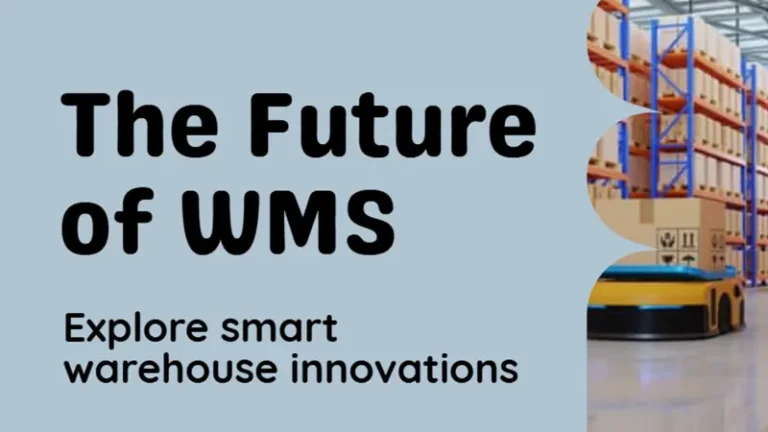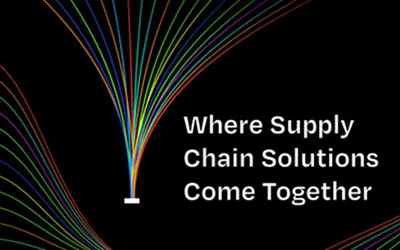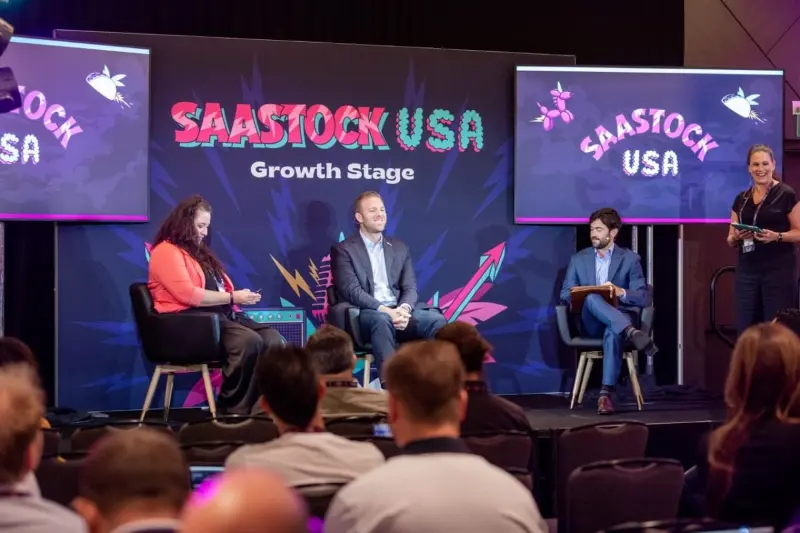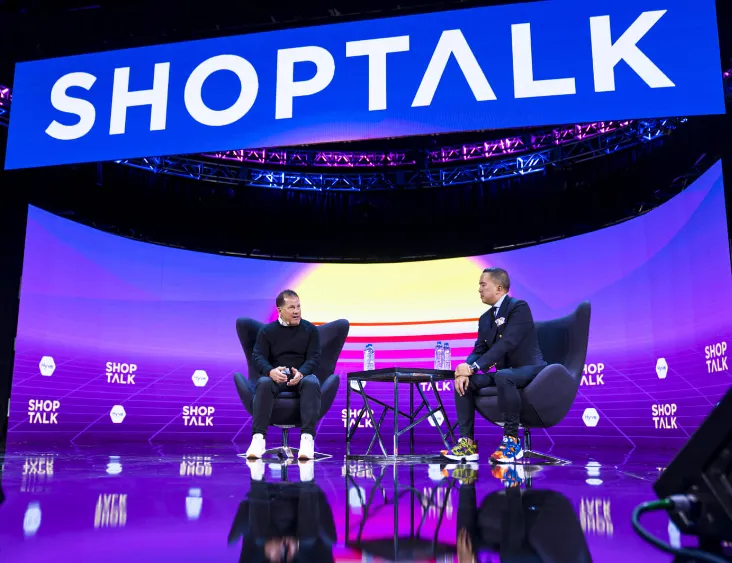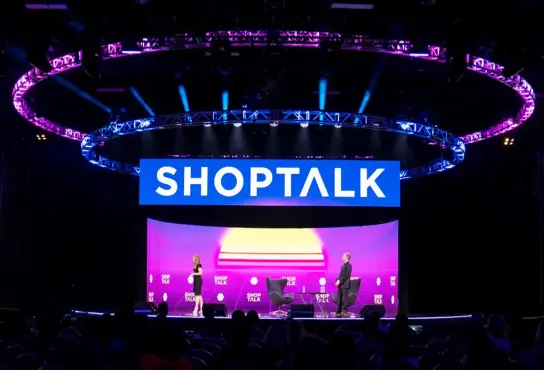NRF’25
In this article
 1 minute
1 minute
January 12-14, 2025 | NYC, NY
Retail’s rapid revolution is here! AI has exploded, social platforms are taking over search engines and Gen Alpha is poised to become the most powerful shoppers ever.
Meet these changes head-on at NRF 2025: Retail’s Big Show, where you can equip yourself with the knowledge and connections to change the rules of the retail game.
Slash Your Fulfillment Costs by Up to 30%
Cut shipping expenses by 30% and boost profit with Cahoot's AI-optimized fulfillment services and modern tech —no overheads and no humans required!
I'm Interested in Saving Time and Money
Turn Returns Into New Revenue
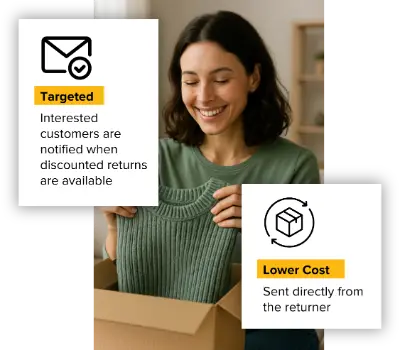
Perplexity’s AI Commerce Experience Misses the Mark in Early Tests
Perplexity, the AI-powered search engine backed by Jeff Bezos, Tobi Lütke, and other notable investors, has just launched a new feature called Buy with Pro. This AI-assisted shopping search engine will let US-based Perplexity Pro subscribers purchase products without leaving the AI search engine. Unlike traditional search engines such as Google, returning a list of ranked sources you must read through to get the answer to your query, Perplexity’s AI search instead reads those ranked sources and summarizes the answer.
The AI Commerce and Shopping Search Experience
The AI commerce experience aims to add a layer on top of AI search that helps users find products that meet their criteria using conversational messages instead of keywords you would type in Google. Users interact with Perplexity in natural language, asking questions and the “prompts,” and then Perplexity will understand that query and return search results, including product recommendations. The new Buy with Pro button allows users to check out using one click on Perplexity’s website. In addition, they have a nice feature called Snap to Shop, which is essentially a visual search like Google Lens. You take a picture of an item, and Snap to Shop can find similar products.
Slash Your Fulfillment Costs by Up to 30%
Cut shipping expenses by 30% and boost profit with Cahoot's AI-optimized fulfillment services and modern tech —no overheads and no humans required!
I'm Interested in Saving Time and MoneyThe Old vs. The New
With a traditional Google Shopping Search, the Shopper enters some keywords into a very old-school interface, which generates a list of product pages that take them to each retailer’s website. After browsing through the images, users must click on each product image that appeals to them and read product specs, read lots of reviews, and figure out whether it’s the right fit or at least a contender.
Whereas what Perplexity is trying to do is make things more intelligent for the Shopper by returning not just a list of product pages but a list of what they call product cards, which summarizes all the information for you with statements like “Buy this if you want a luxurious, oversized cashmere sweater that combines comfort with a timeless, stylish design.” Product cards include high-resolution photos, a summary of the reviews with sources, key features, etc. These are within the Perplexity conversation and in a straightforward format that the Shopper can digest.
Also helpful…users can ask follow-up questions and/or refine the results by updating the conversation, etc. For example, add guidelines such as color, flavor, size, or price.
Our Real Test for an Intended Product
We started our test with a very simple query: “Looking for a cashmere sweater for a party to go with brown pants.” The first results were all the women’s pants!! We didn’t ask for pants; we asked for a sweater to go with pants. And none of the results had the option to Buy with Pro, only to visit the merchant’s website.
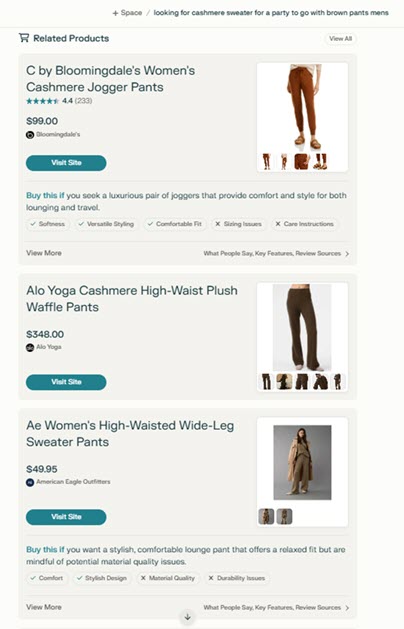
We started a new interaction with the identical prompt. This time, we received brown sweater suggestions, which is closer (do people wear brown sweaters with brown pants? maybe…), but still all women’s styles, while our user profile is configured as a male. So we should be receiving suggestions for men’s sweaters. Again, there were no Buy with Pro options, but we did find a Buy with Shop Pay option this time. Clicking the button brings the user to the Seller’s Shopify store directly to the checkout page to complete the purchase outside the Perplexity environment.
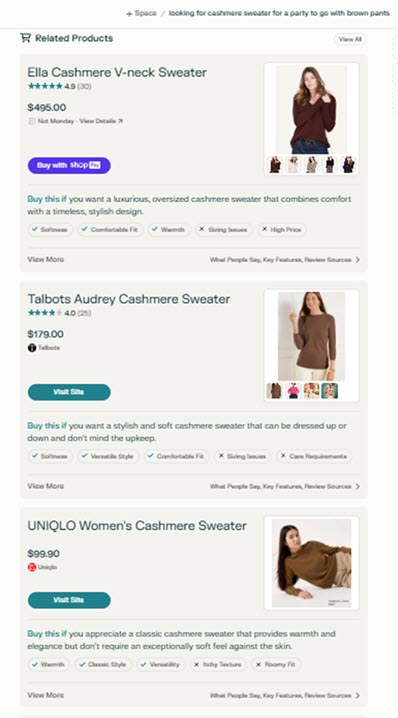
Looking for a New 3PL? Start with this Free RFP Template
Cut weeks off your selection process. Avoid pitfalls. Get the only 3PL RFP checklist built for ecommerce brands, absolutely free.
Get My Free 3PL RFPOn the third attempt, we appended the word ‘mens’ to the end of the prompt. This time, the results were mostly what we would expect, besides disagreement about what color sweaters would go with brown pants, though there was still no Buy with Pro option.
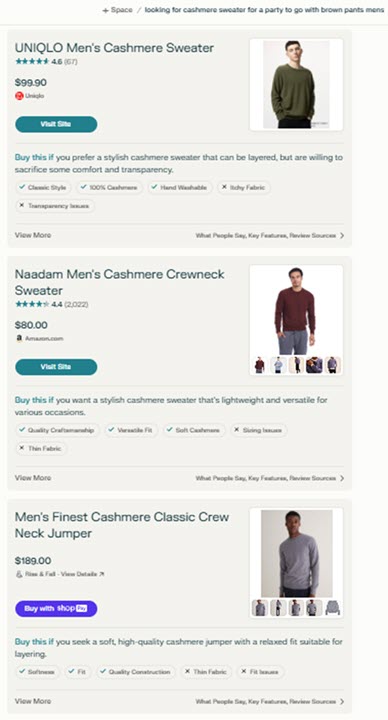
Perplexity Missed the Mark
While this use case for GenAI seems to be a natural fit for GenAI technology, it’s missing the mark. Search results were poor in our tests, suggesting product-market fit might be a long way away. The current solution lacks enough data or the needed intelligence or context.
We’re optimistic about the future of this technology, but in our limited trial/quick test, we weren’t impressed. Generative AI should be able to understand our profile and what we’re looking for and return a men’s sweater and not pants.
Scaling Made Easy: Calis Books’ Fulfillment Journey
Learn how Calis Books expanded nationwide, reduced errors, grew sales while cutting headcount, and saved BIG with Cahoot
See Scale JourneyIt Ain’t All Bad
While search results for the sweater didn’t deliver against expectations, the results did include some thoughtful suggestions about shades and tones to consider for different looks that the shopper might be interested in achieving, as well as tips for accessorizing the outfit:

So, there is promise, but is the product ready? We don’t think so. Again, it’s early, and this was our first couple of queries. But for paid Perplexity Pro users, that’s their first impression, and Shoppers will be disappointed, and Shoppers are very discerning.
Final Thoughts on Perplexity
Perplexity is still a young startup and may figure it out. But trying to compete with the OpenAI’s of the world and launching products prematurely may be a bad idea.
Whether expanding from the Shopify partnership to increase the scale of Buy with Pro or working on understanding the queries better and returning better results, the next move should be figuring out and bridging the gaps. In the era of AI, capturing interest and early users for only $20/month is the easy part. Keeping them, not so much. You can also listen to a recent Perpelixty AI Commerce Search podcast here .

Turn Returns Into New Revenue

Trump’s 2nd Presidency: Pros and Cons for Supply Chain Professionals
The impact of Trump’s next presidency on supply chain professionals appears to be mixed, with potential upsides for domestic transportation and third-party logistics providers but significant risks and challenges in the international supply chain and trade environment. The degree to which the pros outweigh the cons will depend on how the Trump administration’s policies unfold and how businesses can adapt.
Pros:
1. Support for American Manufacturing and Job Growth
Trump’s policies prioritize domestic manufacturing, focusing on stabilizing and expanding the American industrial base. His administration’s proposed tariffs on foreign goods (up to 60% tariff on Chinese imports, a 10-20% universal tariff on all imported goods regardless of origin, and up to 25% tariff on all imports from Mexico) could incentivize companies to shift manufacturing back to the U.S. or source more from domestic suppliers, (reshoring), reducing reliance on foreign suppliers. This could foster job creation and investment in U.S.-based factories, potentially benefiting sectors such as textiles, trucking, and chemicals.
2. Corporate Tax Stability & Benefits
The continuation of the 21% corporate tax rate, introduced during Trump’s previous term, could benefit retailers by keeping operating costs lower than they were pre-2017. Retailers may use the saved funds to reinvest in continued supply chain improvements, digital transformation, and workforce enhancements, potentially making them more resilient. If Trump’s promises come to fruition, companies manufacturing all their products in the USA could save an additional 5% on their income taxes.
Slash Your Fulfillment Costs by Up to 30%
Cut shipping expenses by 30% and boost profit with Cahoot's AI-optimized fulfillment services and modern tech —no overheads and no humans required!
I'm Interested in Saving Time and Money3. Foreign Security Policy
Potential resolution of conflicts in Ukraine and the Middle East could lower global energy costs. Increased defense spending in Europe could support logistics related to defense manufacturers.
4. Incentives for Energy and Manufacturing Industries
Pro-growth tax reform and potential energy-focused policies are anticipated to benefit industries reliant on domestic transportation and energy production, such as trucking and specialty manufacturing, aligning with supply chain needs. For example, increased domestic oil production could lower oil prices to $40-$50 per barrel, nearly half of what it is today, reducing transportation and heating costs.
Cons:
1. Rising Costs for Retailers and Consumers
The potential for increased tariffs on imports, ranging from 10-20% on all imports or up to 60% on goods from China, would significantly increase costs for retailers and consumers. Retailers will likely pass these costs on to consumers, increasing prices and potentially reducing consumer spending. Analysts estimate these tariffs could cost middle-income households an extra $1,700 annually. It could also create a potential strain on transatlantic trade if Europe retaliates with its trade measures.
2. Rising Inflation
The introduction of sweeping tariffs could exacerbate inflation and potentially reduce consumer spending power in an already soft market. Leaders in retail warn about increased costs across essential goods, putting pressure on consumer budgets. This may negatively impact sectors that rely on affordable imported materials, such as apparel and consumer goods.
3. Short-Term Increased Freight Rates and Port Congestion
Anticipation of new tariffs could lead to a short-term surge in U.S. import demand as companies rush to bring in goods before tariffs are implemented, causing a spike in freight rates and port congestion, not to mention port labor issues. During the 2018 tariff hikes, freight rates increased by 70% due to a similar rush (and COVID was worse). A repeat scenario could strain shipping resources and raise logistics and transportation costs, causing importers to fight for spaces on ocean vessels. The rise in COGS means reduced cash flow flexibility. Smaller importers may need to reassess their funding models and pricing strategies to adapt to a higher-cost environment, likely squeezing their profit margins and leading to inventory imbalances and disruptions.
4. Trade Tensions, Retaliatory Tariffs, and Short-Term Instability and Uncertainty
Aggressive trade policies, particularly with China and Mexico, could strain diplomatic and economic relationships, leading to retaliatory tariffs. Such trade tensions could complicate import-export operations and escalate costs for U.S. businesses reliant on global suppliers.
Reigniting a trade war with China, which would further disrupt supply chains and drive up inflation, is a genuine concern. Broad tariffs and stringent trade policies could strain relations with key trading partners, leading to retaliatory tariffs and disrupted trade flows. This could make it challenging for companies to maintain stable international sourcing channels.
Aggressive U.S. trade actions and shifting tax and trade policies may introduce economic uncertainty, market volatility, and business planning challenges, complicating long-term supply chain planning and potentially slowing down investments. Retailers and supply chain executives are concerned that unpredictable changes could disrupt strategic decision-making and provoke retaliatory measures from trading partners, leading to further market volatility and reduced export demand.
Looking for a New 3PL? Start with this Free RFP Template
Cut weeks off your selection process. Avoid pitfalls. Get the only 3PL RFP checklist built for ecommerce brands, absolutely free.
Get My Free 3PL RFP5. Climate Change
Lack of support for global carbon emissions reduction agreements could hinder progress on climate change. Eliminating green energy subsidies could make the transition from gas/diesel engine vehicles less achievable. Delays in progress on climate change policies and commitments could negatively impact the transition to sustainable transportation modes like intermodal rail as well as other clean energy and sustainability initiatives.
Summary:
Pro-growth tax reform and potential energy-focused policies are anticipated to benefit industries reliant on domestic transportation and energy production, such as trucking and specialty manufacturing, aligning with supply chain needs. For example, increased domestic oil production could lower oil prices to $40-$50 per barrel, nearly half of what it is today, reducing transportation and heating costs.
The key theme is that the potential expansion of tariffs and trade barriers under a renewed Trump presidency is a significant threat to the retail and supply chain sectors. While some elements like the corporate tax rate and possible reshoring of domestic manufacturing may be favorable, the overriding concern is the negative impact of protectionist trade policies on costs, inflation, and the ability of businesses to source and distribute goods efficiently.
Retail and supply chain professionals should prepare for increased operational complexities and potential market volatility. For businesses reliant on foreign goods, adjusting to the changing landscape will require robust planning, diversified supply chains, and strategic inventory management.

Turn Returns Into New Revenue

ProMat 2025
In this article
 1 minute
1 minute
March 17-20, 2025 | Chicago, IL
The future of the manufacturing and supply chain industry starts at ProMat, where the brightest minds in the industry come together. In an industry that’s constantly evolving, you have to stay ahead of the curve, which is why ProMat brings together all the products, services, and know-how you need to compete in the world we now live in.
With over 1,100 exhibits, 200 educational seminars and four exciting keynote speeches, ProMat has everything you need to make your operations more resilient, transparent and sustainable.
Slash Your Fulfillment Costs by Up to 30%
Cut shipping expenses by 30% and boost profit with Cahoot's AI-optimized fulfillment services and modern tech —no overheads and no humans required!
I'm Interested in Saving Time and Money
Turn Returns Into New Revenue

Agentforce World Tour NYC
May 21, 2025 | Javits Center | New York, NY
Explore 180+ expert-led sessions, demos, and hands-on trainings. Learn how to power personalized data-driven agents that take action and drive results 24/7 across financial services, retail, media, and more.
Experience the latest agent-first innovation for your business live in NYC. All in one day, all for free.
Slash Your Fulfillment Costs by Up to 30%
Cut shipping expenses by 30% and boost profit with Cahoot's AI-optimized fulfillment services and modern tech —no overheads and no humans required!
I'm Interested in Saving Time and Money
Turn Returns Into New Revenue

SaaStock USA 2024
In this article
 1 minute
1 minute
May 13-15, 2024 | The Palmer Events Center, Austin TX
SaaStock is the world’s most impactful conference for the SaaS community. It brings together the highest concentration of SaaS decision makers, to build relationships and accelerate opportunities. From start to finish, SaaStock is all about facilitating human connections.
The agenda features some of the most exciting names in SaaS, sharing actionable insights that attendees can apply to their own SaaS journeys. Register for the event here.
Slash Your Fulfillment Costs by Up to 30%
Cut shipping expenses by 30% and boost profit with Cahoot's AI-optimized fulfillment services and modern tech —no overheads and no humans required!
I'm Interested in Saving Time and Money
Turn Returns Into New Revenue

SaaStr Annual 2024
In this article
 1 minute
1 minute
Sep 10-12, 2024 | SF Bay Area
Pulse Commerce will see in the Bay Area for SaaStr Annual. 13,000+ SaaS executives, founders, and VCs will come together for SaaStr Annual 2024, the world’s largest SaaS community event on the planet.
Get ready for specific, SaaStr-style actionable advice and learnings to help grow your business from $0 to $100M ARR with less stress and more success. Register for the event here.
Slash Your Fulfillment Costs by Up to 30%
Cut shipping expenses by 30% and boost profit with Cahoot's AI-optimized fulfillment services and modern tech —no overheads and no humans required!
I'm Interested in Saving Time and Money
Turn Returns Into New Revenue

Shoptalk 2024
In this article
 1 minute
1 minute
Mar 17-20, 2024 | Mandalay Bay, Las Vegas, NV
Join the industry’s elite at Shoptalk, the ultimate gathering of retail’s top 10,000+ executives. Held annually in Las Vegas, Shoptalk is an unprecedented gathering of individuals and companies reshaping how consumers discover, shop and buy.
The event provides a platform for large retailers and branded manufacturers, startups, tech companies, investors, media and analysts to learn, network, collaborate and evolve. Pulse Commerce hopes to see you there! You can register here.
Slash Your Fulfillment Costs by Up to 30%
Cut shipping expenses by 30% and boost profit with Cahoot's AI-optimized fulfillment services and modern tech —no overheads and no humans required!
I'm Interested in Saving Time and Money
Turn Returns Into New Revenue

Shoptalk 2023
In this article
 1 minute
1 minute
Mar 26-29, 2023 | Mandalay Bay, Las Vegas, NV
The world’s biggest, most influential and rising retailers and brands unite at Shoptalk for unrivaled business-critical connections, conversations, insights and extraordinary shared experiences to re-imagine the future together.
The Shoptalk agenda covers the latest technologies, trends and business models, as well as the rapid transformation of what consumers discover, shop for and buy—everything ranging from apparel and electronics to beauty and grocery. We look forward to seeing you there! You can register here.
Slash Your Fulfillment Costs by Up to 30%
Cut shipping expenses by 30% and boost profit with Cahoot's AI-optimized fulfillment services and modern tech —no overheads and no humans required!
I'm Interested in Saving Time and Money
Turn Returns Into New Revenue

Build an Efficient Supply Chain: 5 Obstacles to Overcome
Ecommerce is experiencing an extreme, extended boom that is showing no signs of stopping.
Thanks in part to the pandemic, online shopping is now ubiquitous. As of 2022, 93.5% of internet users have purchased something online.
But as ecommerce grows and more and more sellers make the jump online, the pains of profitable scaling present themselves much clearer.
One of the biggest differences from physical retail that ecommerce businesses face is the way in which they organize their operations. Simply put, ecommerce order fulfillment is much more challenging and costly than replenishing retail shelves.
When selling to customers, delivering the product can be where the rubber meets the road for a seller’s profitability. While it seems like online shopping has been around forever, the fulfillment industry has taken longer to catch up with this new normal. Thankfully, there are now purpose-built solutions for ecommerce’s logistics challenges.
In this article, we look at the 5 most common fulfillment obstacles that ecommerce companies face and provide guidance on how to overcome them with modern tools.
Slash Your Fulfillment Costs by Up to 30%
Cut shipping expenses by 30% and boost profit with Cahoot's AI-optimized fulfillment services and modern tech —no overheads and no humans required!
I'm Interested in Saving Time and Money1. Unstable supply chain costs
The rising costs of oil and gasoline have headlined inflation troubles around the world. Few have felt the impact of these rising prices more than the logistics industry – and thus ecommerce sellers.
Fuel makes up a significant portion of the total cost of delivery operations, whether you use it for airplanes, cargo, or delivery vans. Faced with increased costs, fulfillment services are passing on the costs to their customers, ecommerce merchants. In the past few months, both Amazon and Walmart have added fuel surcharges to their prices for Fulfillment by Amazon and Walmart Fulfillment Services, eating into sellers’ margins.
The intuitive thing for a seller to do is to pass the cost on in turn to customers via shipping fees, but 55% of shoppers say they abandon a cart when the additional costs are too high. Price competition online is brutal thanks to how easy it is to find competing products, so sellers have been left battling ever-narrowing margins.
In the short term, a workaround would be to work your delivery fee — or a portion of it — into your product pricing so buyers don’t feel it as much. Another option would be to offer bulk orders at a discount so they can save money when they buy more in one go.
These short-term solutions leave you vulnerable to being undercut by the competition, though. The only lasting solution to rising logistics costs is to adopt a fundamentally lower-cost model. You need to store your inventory close to customers across the country, so that no matter where an order is placed, it can be delivered to them quickly and efficiently via ground shipping. Modern fulfillment networks like Cahoot are designed with ecommerce in mind and will strategically distribute your inventory across the country, lowering your shipping costs to the minimum possible.
2. Changing customer purchasing behavior
Another of the more common ecommerce fulfillment challenges isn’t in the industry itself but in the end users. People’s behaviors are changing.
For one, payment behaviors are rapidly shifting due to innovation in online payments. Whereas people once paid primarily through credit cards, many buyers are turning to e-wallets. This has had a bigger-than-anticipated effect on conversion for online merchants, many of whom are observing their cart abandonment rates edge upwards without the options that people want.
The straightforward solution for ecommerce businesses is to have multiple payment channels on your website. Provide at least three options for your customers to choose which payment channel works best for them.
The three payment options you should have at the bare minimum are credit card, debit card, and e-wallet. If you want to go further, there are now online payment tools that aggregate many more than three options and enable all of them at once on your site. Consumers can pick their favored option (usually one that already has their information saved) and quickly check out. In this way, the right checkout option can boost your conversion.
Looking for a New 3PL? Start with this Free RFP Template
Cut weeks off your selection process. Avoid pitfalls. Get the only 3PL RFP checklist built for ecommerce brands, absolutely free.
Get My Free 3PL RFP3. Poor product handling across the supply chain
You must know the pains and headaches of dealing with a damaged or expired product, either as a buyer or a seller. Poor delivery experiences are devastating to an ecommerce sellers’ profitability. The hit comes in three places – one, you have to process a return. Two, you have to send a new item and write down the damaged one. And third, you likely will lose the customer! Most sellers lose money to convert new customers, and then build a profitable business through repeat purchases. Damaged products threaten lost customers and a severe hit to the bottom line.
While some delivery damages happen due to carrier negligence and cannot be avoided, a lot of them can be mitigated or minimized with smart fulfillment strategies. Third party logistics (3PL) companies that don’t specialize in ecommerce likely don’t know what it takes to safely package a product to be sent to a customer. If the 3PL company has been around for a long time and grew through retail replenishment, they’re used to shipping in bulk. On the other hand, warehousing services that are build specifically for ecommerce know how to store and pack single products ordered online to minimize damage.
Using manual and automated inventory management systems, warehousing partners can track notes on certain inventory so they know how to handle them best and avoid any food spoilage because of wrong room temperatures and other storage conditions. Inventory management solutions make it easier for warehousing staff to track handling concerns and requests. The added edge of automated inventory management will help avoid any unwanted damages to the products such as breakage, spoilage, and so on.
4. Rider and delivery crew reliability
With the growth of just-in-time last-mile services, there have been growing challenges to manage that part of the fulfillment process. Restaurants face various last-mile delivery challenges, but one of the most common has to be rider reliability. While many riders remain reliable and competent, there will always be a bad bunch that stain the reputation of a business and its merchants.
Using some form of feedback system to gather insights into rider performance is crucial in this sense. Companies, whether the riders or the merchants, should also use these systems to evaluate whether they should work with a certain rider or not. For instance, if you have a rider that has a star rating lower than three, then it should be a signal for a last-mile delivery company, merchant, or customer to not do any business with that service provider.
5. Lack of efficient supply chain processes
As author of Atomic Habits James Clear once stated, “You do not rise to the level of your goals. You fall to the level of your systems.”
That principle doesn’t just apply to personal productivity. It applies to business efficiency too. A fulfillment and delivery operation must have systems and processes that are optimized for the task at hand. This extends to your fulfillment provider, who must be optimized for ecommerce, and to you and the way in which you communicate with your customer after they’ve placed an order.
For example, giving timelines on your delivery should be a part of your system. Currently, 24% of online buyers will abandon an order if no delivery date is provided. Amazon set the standard for “date certain” delivery, as it’s called, and now it’s an expectation that all online sellers must meet. You should be able to supply that information with an order tracking system to remove the buyer anxiety most people who order online might feel.
Of course, date certain delivery won’t be a positive experience for your customers if the date they see is more than a week in the future, or if they had to pay an arm and a leg for shipping. This is where your fulfillment provider also must be optimized for the world of modern ecommerce. As we mentioned before, if they haven’t built a network that blankets the country in warehouses, and if they don’t have intelligent software that can govern where each order should ship from, they simply can’t support your needs. You need fast shipping at a low cost to compete – and anything other than a nationwide network of ecommerce warehouses can’t do that for you.
Scaling Made Easy: Calis Books’ Fulfillment Journey
Learn how Calis Books expanded nationwide, reduced errors, grew sales while cutting headcount, and saved BIG with Cahoot
See Scale JourneyFulfillment defines efficient ecommerce supply chains
Learning how to solve fulfillment challenges is crucial for any ecommerce business. As the world of online buying and selling grows, your options for cutting-edge ecommerce fulfillment operations expand as well. You don’t need to operate your own warehouses to win. Even small to medium businesses can make the world their oyster and sell everywhere if they pick the right fulfillment provider that will help them win new customers and keep their costs low.
Cahoot’s nationwide network of over twenty warehouses provides affordable national ecommerce order fulfillment for online merchants. Thier wide and diverse network enables them to fulfill a wide variety of needs, from sellers who need absolute peak speed at minimum cost to those that have fragile items or others that require special handling.
Their fulfillment centers are outfitted with dedicated personnel and technology that creates an efficient supply chain:
- Efficient picking enables late 2pm order cutoffs
- Barcode scanning all but eliminates incorrect orders
- Intelligent pick and pack software optimizes boxes for every order, minimizing shipping cost for complex orders
- Lowest cost by design
Getting started with Cahoot is fast and easy – with pre-built integrations for major ecommerce channels like Amazon, Walmart, Shopify, and BigCommerce, they can get merchants started in as little time as it takes to send us your inventory.
Talk to one of their experts today and explore how we can be the key that unlocks the next level of your profitable ecommerce growth.

Turn Returns Into New Revenue





